| LIST OF REFERENCE NUMERALS |
| 10 vehicle microtagging system |
26 ultraviolet light |
| 11 microtag particles |
28 magnification instrument |
| 12 paint |
30 database |
| 14 vehicle |
32 vehicle information |
| 16 motor vehicle accident scene |
34 paint sprayer |
| 18 hit and run victim |
36 vehicle painter |
| 20 residual sample |
38 microtag retrieval |
| 22 tag retrieval personnel |
40 microtag indicator |
| 24 unique alphanumeric sequence
|
|
|
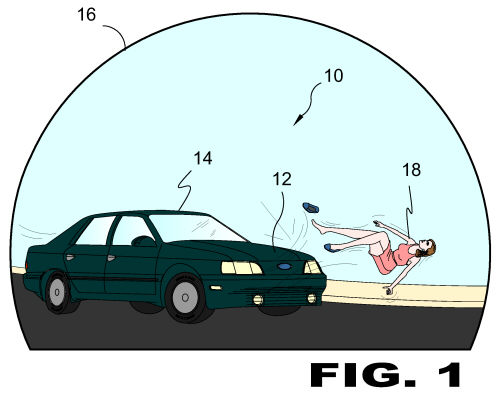 |
| FIGURE 1 FIGURE 1 is an illustrative view of the present invention in use. The present invention is a vehicle microtagging system 10 which provides microscopic particles (microtags) dispersed in vehicle paint 12 to assist in identifying a vehicle 14 when only a residual sample of paint from the vehicle 14 is available, for example, as from a hit and run motor vehicle accident scene 16. Shown is a motor vehicle accident scene 16 comprising a vehicle 14 striking a hit and run victim 18. The method for identifying a motor vehicle from paint residue removed from the motor vehicle 14 comprises the steps a) providing a motor vehicle microtagging system having paint 12 applied to a motor vehicle 14 with a plurality of microtags dispersed in the paint 12, each microtag bearing the same unique alphanumeric sequence; b) recovering a residual paint sample; c) retrieving the unique alphanumeric sequence from the microtags dispersed in the residual paint sample; and d) identifying the motor vehicle 14 by the unique alphanumeric sequence.
|
 |
| FIGURE 2 FIGURE 2 is an illustrative view of the present invention in use. The present invention is a vehicle microtagging system 10 which provides microscopic particles (microtags) dispersed in vehicle paint to assist in identifying a vehicle 14 when only a residual sample 20 of paint from the vehicle 14 is available, for example, as from a hit and run motor vehicle accident scene 16. Shown is a motor vehicle accident scene 16 comprising a vehicle 14 leaving an accident scene 16 after striking a hit and run victim 18. At the accident scene 16, residual samples 20 of paint, including the microtags 11, remain as evidence.
|
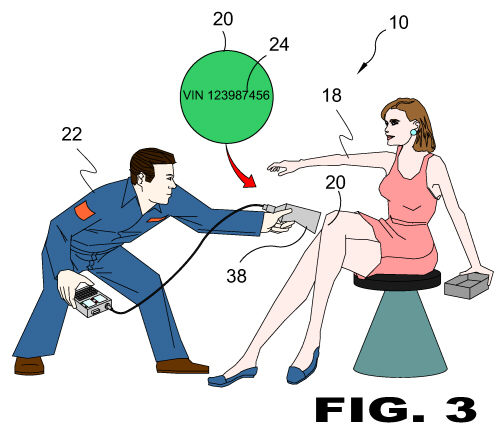 |
| FIGURE 3 FIGURE 3 is an illustrative view of the present invention in use. Shown is an illustration depicting the recovery of residual samples 20 of paint including the microtags of the invention. The present invention is a vehicle microtagging system 10 which provides microscopic particles (microtags) dispersed in vehicle paint to assist in identifying a vehicle when only a residual sample 20 of paint from the vehicle is available, for example, as from a hit and run motor vehicle accident scene. At the accident scene, residual samples 20 of paint, including the microtags, remain as evidence. The residual sample 20 is identified and collected by tag retrieval personnel 22 utilizing microtag retrieval equipment 38, such as a law enforcement officer, and the unique alphanumeric sequence 24 is retrieved by means including one or more of an ultraviolet light 26 and a magnification instrument. Each microtag bears the same unique alphanumeric sequence 24, which is preferably the same as the vehicle identification number (VIN) assigned to the vehicle. Shown is the microtag retrieval personal 22 recovering a residual sample 20 off of the victim 18.
|
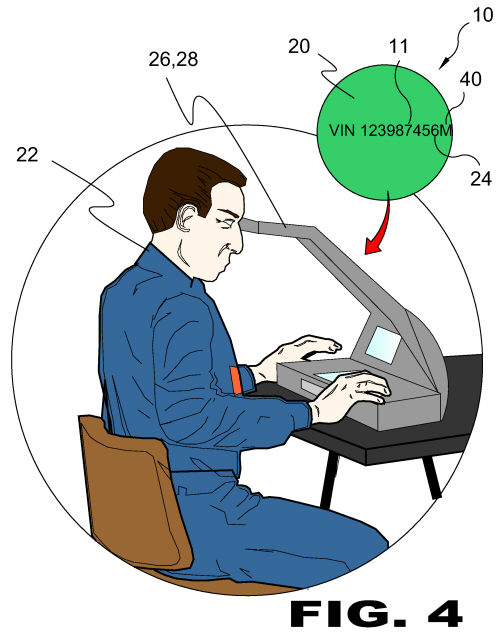 |
| FIGURE 4 FIGURE 4 is an illustrative view of the present invention 10 in use. Shown is an illustration depicting the recovery of microtagging identification particles 11 mixed in residual vehicle paint samples 20. Shown is an illustration depicting the recovery and analysis of residual samples 20 of paint including the microtags 11 of the invention. The present invention is a vehicle microtagging system 10 which provides microscopic particles (microtags) 11 dispersed in vehicle paint to assist in identifying a vehicle when only a residual sample 20 of paint from the vehicle is available, for example, as from a hit and run motor vehicle accident scene. A residual sample 20 is processed by tag retrieval personnel 22, such as a law enforcement officer, and the unique alphanumeric sequence 24 having a microtag indicator 40 is retrieved by means including one or more of an ultraviolet light 26 and a magnification instrument 28. A preferred magnification instrument 28 is a 100x magnifier. Each microtag 11 bears the same unique alphanumeric sequence 24, which is preferably the same as the vehicle identification number (VIN) assigned to the vehicle.
|
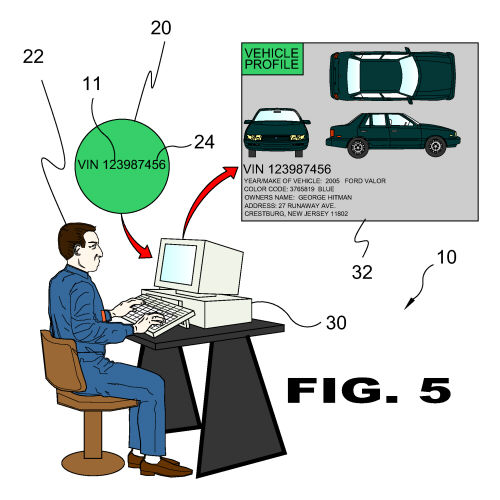 |
| FIGURE 5 FIGURE 5 is an illustrative view of the present invention in use. Shown is an illustration depicting the recovery and analysis of residual samples 20 of paint including the microtags of the invention. The present invention is a vehicle microtagging system 10 which provides microscopic particles (microtags) dispersed in vehicle paint to assist in identifying a vehicle when only a residual sample 20 of paint from the vehicle is available, for example, as from a hit and run motor vehicle accident scene. A residual sample 20 is processed by tag retrieval personnel 22, such as a law enforcement officer, and the unique alphanumeric sequence 24 is retrieved by means including one or more of an ultraviolet light and a magnification instrument. Each microtag 11 bears the same unique alphanumeric sequence 24, which is preferably the same as the vehicle identification number (VIN) assigned to the vehicle. Optionally, a database 30 correlates the unique alphanumeric sequence 24 with vehicle information profile 32, the database 30 accessible in order to retrieve vehicle information 32 about a vehicle for which the alphanumeric sequence 24 is known.
|
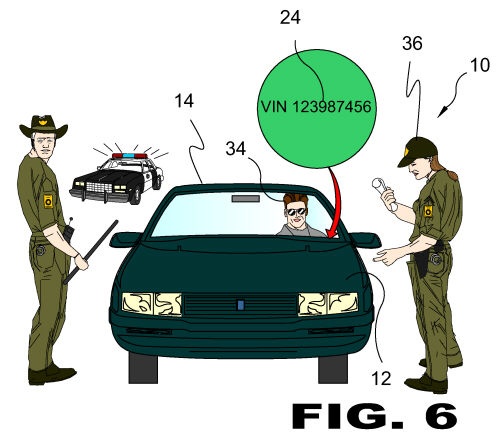 |
| FIGURE 6 FIGURE 6 is an illustrative view of the present invention in use. Shown is an illustration depicting the arrest of a hit and run driver and a vehicle having the microtagging identification particles. The present invention is a vehicle microtagging system 10 which provides microscopic particles (microtags) dispersed in vehicle paint 12 to assist in identifying a vehicle 14 when only a residual sample of paint from the vehicle 14 is available, for example, as from a hit and run motor vehicle accident scene. After the vehicle 14 is identified from the unique alphanumeric sequence 24 in the residual sample, the hit and run driver 34 can be apprehended and arrested by law enforcement personnel 36.
|
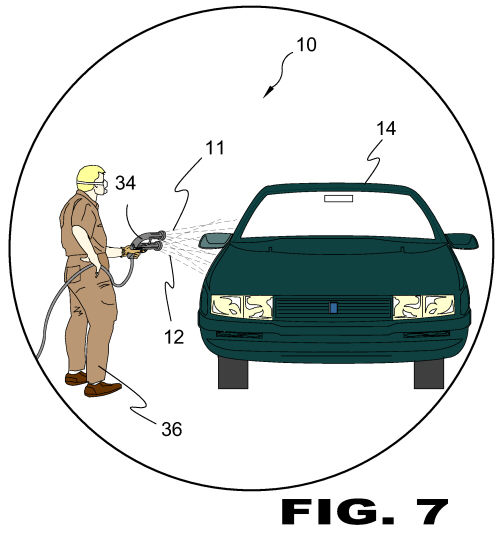 |
| FIGURE 7 FIGURE 7 is an illustrative view of the present invention 10 in use. The present invention provides a method for marking a vehicle comprising the steps: a) providing a vehicle microtagging system having paint 12 for applying to a vehicle 14 and a plurality of microtags 11 dispersed in the paint, each microtag bearing the same unique alphanumeric sequence; and b) applying the paint to a vehicle, for example by means such as with a paint sprayer 34, applied by a vehicle painter 36.
|
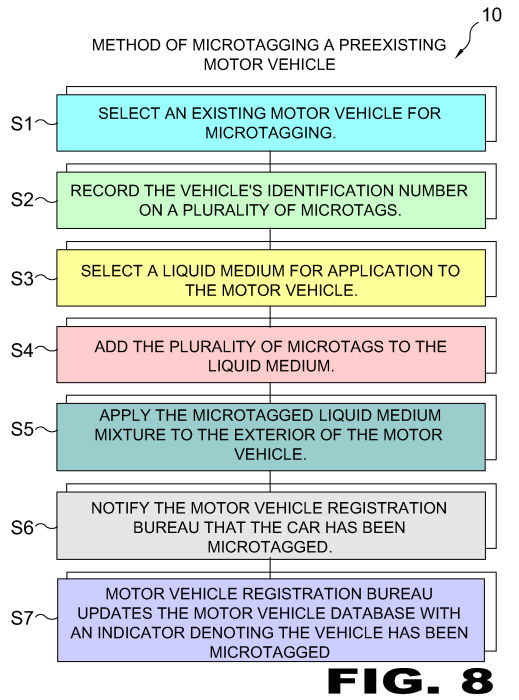 |
| FIGURE 8 Figure 8 is a block diagram of a method of microtagging a pre-existing motor vehicle. The present invention provides for elective microtagging of existing motor vehicles comprising the steps of selecting an existing motor vehicle for microtagging, as shown in S1. In step S2, the vehicle's identification number is recorded onto a plurality of microtags and a liquid medium is selected, which may be a paint pigment or clear coat, as shown in step S3. In step S4 the microtags are combined with the liquid medium to form a sprayable mixture that is applied to said motor vehicle, as shown in step S5. Once the motor vehicle has been microtagged through application of the microtagged mixture, the vehicle registration bureau is notified, shown in S6, so that the bureau's database can be updated indicating that the vehicle has been microtagged, as shown in step S7.
|
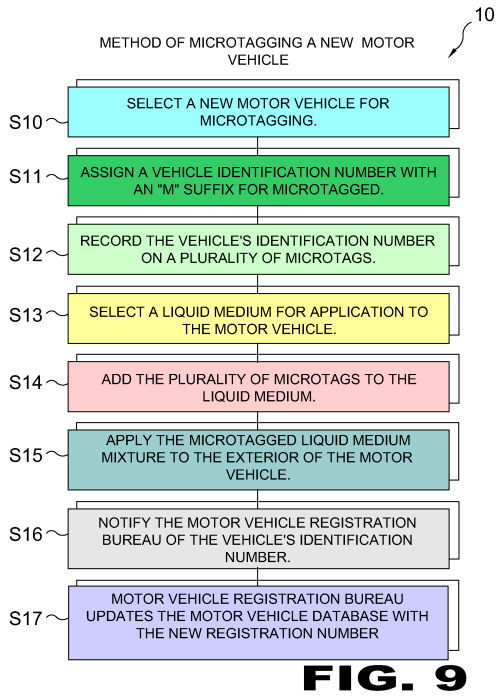 |
| FIGURE 9 Figure 9 is a block diagram of a method of microtagging new motor vehicles. The present invention provides that microtagging new motor vehicles will encourage vehicle operators to be more responsible in their operation. In step S10, a motor vehicle is selected for microtagging and a visual indicator is added to the identification number, preferably a suffix letter such as 'M', as shown in step S11. In step S12, the vehicle's identification number is recorded onto a plurality of microtags and a liquid medium is selected, which may be a paint pigment or clear coat, as shown in step S13. In step S14 the microtags are combined with the liquid medium to form a sprayable mixture that is applied to said motor vehicle, as shown in step S15. Once the motor vehicle has been microtagged through application of the microtagged mixture, the vehicle registration bureau is notified, shown in S16, so that the bureau's database can be updated indicating that the vehicle has been microtagged, as shown in step S17.
|
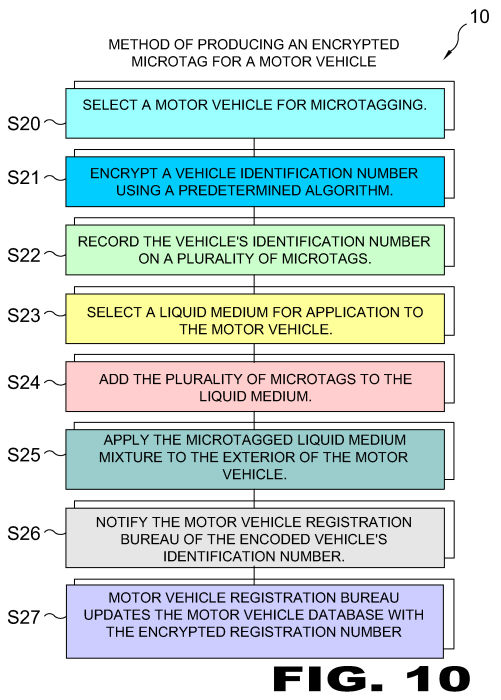 |
| FIGURE 10 Figure 10 is a block diagram of a method of producing an encrypted microtag for a motor vehicle. The present invention envisions that there may be circumstances where the identity of vehicles used within a government agency require anonymity for national security purposes. Therefore, the present invention provides for encoding or encrypting the vehicle identification number. In step S20, a motor vehicle is selected for microtagging and the vehicles identification number is encrypted using a predetermined algorithm as shown in step S21. In step S22, the vehicle's identification number is recorded onto a plurality of microtags and a liquid medium is selected, which may be a paint pigment or clear coat, as shown in step S23. In step S24 the microtags are combined with the liquid medium to form a sprayable mixture that is applied to said motor vehicle, as shown in step S25. Once the motor vehicle has been microtagged through application of the microtagged mixture, the vehicle registration bureau is notified, shown in S26, so that the bureau's database can be updated indicating that the vehicle has been microtagged, as shown in step S27.
|
|